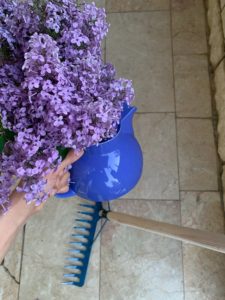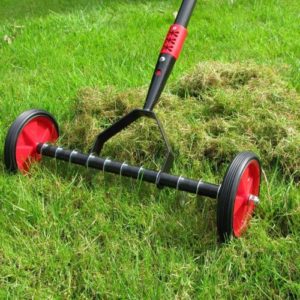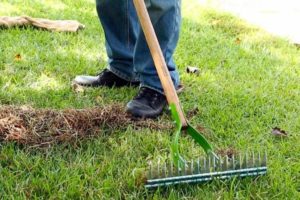How to get rid of dead grass without a lawn mower? The method to get rid of dead grass, also known as thatch, is crucial for the health and appearance of the lawn. Thatch can suffocate the grass and prevent water, nutrients, and oxygen from reaching the roots. Moreover, it can create a conducive environment for the proliferation of pests and diseases.
Before diving into the methods, it’s worth noting that each method’s choice will depend on various factors such as the size of the lawn, the severity of the thatch problem, the available resources and personal preference. It’s also important to remember that while these are alternatives to a lawn mower, certain safety precautions should still be followed to prevent injuries.
Lawn Care 101: How to Get Rid of Dead Grass Without a Lawn Mower
When it comes to maintaining a well-groomed lawn, removing dead grass is an essential step. However, not everyone has access to a lawn mower, and even when they do, sometimes a more meticulous and gentle approach is preferable. Here, we will explore the different methods of removing dead grass without the use of a lawn mower.
Method 1: Hand Raking
One of the most straightforward methods to get rid of dead grass without a lawn mower, also known as thatch, is by using a garden rake. This simple tool is not only affordable, but it also allows for precise control over the areas you work on.
Note: While this method can be labor-intensive, it proves to be extremely effective, particularly for smaller lawns.
To rake your lawn effectively, follow these steps:
- Water the lawn: Before you start raking, ensure the lawn is slightly damp. This makes the process of raking easier and less likely to harm the remaining healthy grass.
- Rake the lawn: Use your rake to comb through the grass, pulling up the layers of dead grass. Be sure to rake deeply enough to remove the thatch but not so deep as to harm the roots of the healthy grass.
- Collect and dispose of the dead grass: Once you’ve finished raking, collect the dead grass and dispose of it properly. It can be added to a compost pile if one is available.
Pros and Cons of Using a Handrake
One of the traditional yet efficient methods of cutting grass without a lawnmower is by using a hand rake. This old-school tool, often found in the sheds of many homes, can effectively remove dead grass from your lawn. However, like any tool, the hand rake comes with its advantages and disadvantages.
Pros of Using a Hand Rake
- Cost-Effective: Compared to high-tech gardening tools, a hand rake is a budget-friendly option. It doesn’t require fuel or electricity to operate, resulting in substantial savings over time.
- Environmentally Friendly: A hand rake leaves a minimal carbon footprint. It doesn’t emit harmful gases like a gasoline-powered lawnmower would, making it an eco-friendly choice for maintaining lawns.
- Physical Exercise: Though it may be more labor-intensive, using a hand rake can provide a decent outdoor workout, strengthening muscles and improving cardiovascular fitness.
Cons of Using a Hand Rake
- Time-Consuming: A significant downside to using a hand rake is the time it consumes. Raking a large lawn manually can take several hours, possibly even days, depending on the size and condition of the lawn.
- Physical Strain: Continuous raking can lead to backaches and muscle strains, especially for those unaccustomed to this type of physical activity. It’s important to take regular breaks and use proper technique to avoid injury.
- Inefficient for Large Areas: While a hand rake may be sufficient for small lawns, it is not the best tool for larger areas. The effort and time required increase exponentially with the size of the lawn.

Hand Rake
Method 2: Using a Dethatching Blade
A dethatching blade or dethatching rake is a specialized tool designed specifically for the purpose of removing dead grass. This tool can be attached to the end of a standard broom handle and used to comb through the grass, much like a regular rake. However, the design of the dethatching blade allows it to effectively cut through and lift the dead grass with less effort.
To use a dethatching blade effectively, follow these steps:
- Prepare the lawn: As with hand raking, it’s important to water the lawn lightly before you start dethatching. This softens the soil and makes the process easier.
- Use the dethatching blade: Run the dethatching blade through the grass, being sure to cover the entire lawn. The blade should lift and cut through the layer of dead grass.
- Collect and dispose of the dead grass: After you’ve finished dethatching, collect the dead grass and dispose of it properly.
When it comes to maintaining a lawn, eliminating the build-up of dead grass is a task that can’t be overlooked. One of the effective ways to go about this is by using a dethatching blade. This tool has its set of advantages and disadvantages which we will delve into in this article.
Pros of a Dethatching Blade
| Benefit | Description |
|---|---|
| Effectiveness | A dethatching blade is highly effective in removing dead grass from the lawn. It lifts and cuts through the layer of thatch efficiently. |
| Time Saving | Compared to hand raking, using a dethatching blade is a quicker and more efficient way to rid your lawn of dead grass. |
| Ease of Use | With a bit of practice, using a dethatching blade can be a straightforward process. The blade can cover the entire lawn, making it easier to ensure all areas are dethatched. |
Cons of a Dethatching Blade
| Drawback | Description |
|---|---|
| Potential Damage | A dethatching blade can potentially damage the lawn if not used correctly. For instance, it may cut too deep into the soil, harming the healthy grass. |
| Disposal of Thatch | After dethatching, the layer of dead grass needs to be collected and disposed of properly. If left unchecked, they can decompose and create a new layer of thatch. |
| Physical Effort | While it may be easier than hand raking, using a dethatching blade still requires a considerable amount of physical effort, especially for larger lawns. |
Every tool has its benefits and drawbacks. Understanding these can help you make the best decision for your lawn maintenance needs.
Dethatching Rake
Source:Amazon.com
Method 3: Using a Scarifier
A scarifier is a larger, more powerful tool that is used to remove dead grass on a larger scale. This tool is particularly useful for larger lawns or areas with a significant amount of thatch.
To use a scarifier effectively, follow these steps:
- Prepare the lawn: Similar to the previous methods, the lawn should be lightly watered before using a scarifier.
- Use the scarifier: Run the scarifier over the lawn in a pattern similar to mowing. The scarifier will cut into the soil slightly and pull up the dead grass.
- Collect and dispose of the dead grass: After you’ve finished scarifying, collect the dead grass and dispose of it properly.
Pros and Cons of Using a Scarifier
A scarifier is a tool specifically designed to remove thatch and moss from your lawn, promoting healthier grass growth. However, like any tool, it has its advantages and disadvantages. Let’s explore both aspects to give you a clear understanding of whether it’s the right choice for your lawn care needs.
| Pros | Cons |
|---|---|
| Effective at removing thatch and moss from your lawn | Can be damaging if used incorrectly |
| Improves soil aeration, promoting healthier grass growth | Could require a significant investment if a large area needs to be covered |
| Prevents water-logging and enhances nutrient absorption | Requires physical effort and time to use |
| Easy to use with minimal training | Not suitable for use on young or newly seeded lawns |
Remember, using a scarifier can be beneficial for your lawn, but it’s crucial to use it correctly to avoid damaging your grass. It’s always helpful to consult with a lawn care expert if you’re unsure.
It’s also important to understand that scarifying is only one part of lawn maintenance. Effective lawn care also involves regular watering, feeding, and mowing, along with the occasional need for reseeding. Considering all these aspects will ensure your lawn remains healthy and vibrant.

Scarifier
Source: Gardening-Naturally
CONCLUSION
In conclusion, maintaining a healthy, vibrant lawn does not necessitate theuse of a lawn mower. With the right tools and techniques, you can effectively get rid dead grass without lawn mower and promote the growth of healthy, green grass. Whether you choose hand raking, a dethatching blade, or a scarifier, your lawn can be well-maintained and neatly groomed without a lawn mower.


